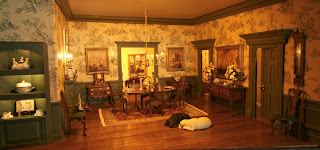I made this
jewelry and perfume counter a while ago, but (true to form) didn't quite finish it. I knew I wanted to add a bunch of glossy black shopping bags to this display, but that idea seemed like more work than I wanted to tackle at the time, so I put it aside. That time away turned out to be a good thing, since this process is much more streamlined than my initial ideas!
I love this method of making shopping bags, because it doesn't require any paper patterns or measuring, but it's very easy to make identical bags. The secret is to fold them around a block of wood.
You will need:
paper for your shopping bag
scissors
balsa wood
a ruler/straight edge
pencil
white, cloth covered wire
glue (I used tacky)
The thickness and width of your wood will determine the size of your bag. I glued two pieces together to get the right width for the my bag. Decide the height that you want the bag to be, and mark that on the wood, all the way around.
Cut a strip of paper for your bag. I used a very thin, glossy black paper. The exact measurements of the paper strip don't matter, so long as it is long enough to go around the block of wood, and taller than height you marked on your wooden block.
Wrap the strip of paper around the wood, using your fingers to crease the paper at the corners.
Take the paper off the wood. Crease the paper again so that the folds are sharp.
Wrap the paper around the wood again. Use a little glue to glue the paper into a tube.
Slide the paper down the wood until one edge of the paper tube is lined up with the pencil line, and the other edge hangs off.
Wrap and glue the paper around the end of the wood, like you are wrapping a package.
Slide the paper bag off the wood.
Pinch the sides of the bag inwards, starting at the top of the bag and going as far down as you can. It is easier to do both sides at once, but I had to take the photograph!
The basic bag is finished.
To make the handles, simply cut two pieces of cloth covered wire, and wrap them around the handle of a paintbrush to shape them.
Glue the handles in place.
Finally, fill the bag with tissue paper. The black and white bag I made for this tutorial is about as basic as you can get, but it's easy to change up the look of these bags by using patterned paper, adding labels, or using different sizes of wood to create a variety of sizes. The sky is the limit!











































































.jpg)
































































.JPG)























+(2).jpg)






















